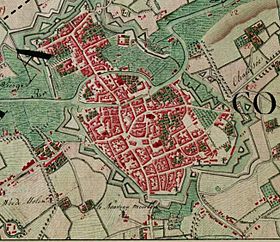Battle of Courtrai (1793) facts for kids
Quick facts for kids Battle of Courtrai (1793) |
|||||||
|---|---|---|---|---|---|---|---|
| Part of the War of the First Coalition | |||||||
 Map of Kortrijk by Joseph de Ferraris |
|||||||
|
|||||||
| Belligerents | |||||||
| Commanders and leaders | |||||||
| Strength | |||||||
| 6,000 | 16,500 | ||||||
| Casualties and losses | |||||||
| 100 | 400 | ||||||
The 1st Battle of Courtrai happened on September 15, 1793. It took place near Courtrai, which is now known as Kortrijk, Belgium. This battle was part of the Flanders Campaign during the Wars of the French Revolution. It happened just two days after the Battle of Menin. The fight was between a French army division led by Joseph de Hédouville and an Austrian force under Johann Beaulieu. British soldiers also supported the Austrians. The battle ended with a victory for the Allied forces (Austrians and British). This defeat stopped the French commander Nicolas Houchard's campaign. It also led to Houchard being removed from his command and later facing serious consequences.
Why the Battle Happened
After winning the Battle of Hondschoote and helping to end the siege of Dunkirk, General Houchard changed his plans. He wanted to stop the British in the north with 20,000 soldiers. Then, he planned to march with the rest of his army to help Le Quesnoy. Le Quesnoy was under attack by a large part of the Imperial army.
Houchard's first goal was to capture Tournai. But first, he needed to deal with the Dutch army. The Dutch, led by Prince William of Orange, had moved back from Ypres to Menin. They first thought about retreating to Courtrai. However, they heard that Le Quesnoy had fallen on September 11. They also learned that 15,000 Austrian soldiers would support them. So, the Prince of Orange decided to stay and fight at Menin.
On September 12, Houchard badly defeated the Prince of Orange at Menin. The Dutch then left Courtrai and retreated towards Ghent.
The French army had now created a dangerous bulge in the Allied battle lines. This bulge threatened to cut off communication. It was between the British army in the north and the main Imperial army. The Imperial army was still around Le Quesnoy. When the British commander, the Duke of York, heard about the Dutch defeat, he moved his troops to cover them. Beaulieu's Austrian forces also pulled back to Lendelede.
However, Houchard did not know that Le Quesnoy had fallen. He kept planning to move east. He ordered the divisions of Joseph de Hédouville and Pierre Dumesny to advance south towards Lille.
The Battle Itself
On the evening of September 14, Beaulieu and his 6,000 soldiers took control of Courtrai. On the same day, the Duke of York's troops reached Thorout. There, in a meeting, he decided to attack Menin.
On September 15, as York marched towards Menin, Hédouville left Menin. He sent Demars' brigade of 3,000 men along the Lys river. Their job was to threaten Courtrai. Demars was not happy about this risky task. But he was told he would be reported to Houchard if he didn't obey. He was told, "He must take Courtrai or burn it with his shells."
The Duke of York was on his way to Rousselare (Roulers) when he heard the news. He immediately sent General Erbach to help Beaulieu's Austrians. Erbach commanded the advance guard of Hanoverian infantry and British cavalry. Four more battalions followed him.
As Demars' troops got close to Courtrai, Beaulieu's soldiers came out of the town. They pushed the French back. Hédouville brought more soldiers from Menin to help. But these troops were also forced back. The Austrians chased them closely.
Most of Hédouville's division was on its way to Lille. So, Demars was left outside Menin to hold off the Allies until night. But when Erbach's troops appeared, the French soldiers started to flee. Daendels, who was in command in Menin, managed to hold out for a short time. But then panic spread again, and Menin was abandoned. Many French soldiers drowned in the river as they tried to escape.
The Anglo-Austrian chase was only stopped by Antoine Béru. He used some light guns to hold them off. For this, he was promoted to a higher rank the next day. The French lost 500 soldiers killed or wounded. They also lost 200 prisoners and 2 cannons.
What Happened Next
Even though the number of soldiers lost was not very high, Beaulieu's victory was important. This, along with the loss of Le Quesnoy and another French defeat on September 11, changed everything. It brought Houchard's campaign to an end. Very quickly, the French army was back in the defensive positions they had been in before the Battle of Hondschoote.
However, the French army's fast retreat also meant the Allies missed a chance. They narrowly avoided a bigger disaster. The French could have been trapped between York's forces in the north, Beaulieu's in the east, and the main army advancing from the south.
Hédouville and Dumesny were both arrested, but they were not executed. On September 24, Houchard was arrested in Lille. He was accused of not using his victory at Hondschoote well. He was also blamed for the loss of Le Quesnoy. Houchard faced a trial and was put to death in Paris on November 17.

